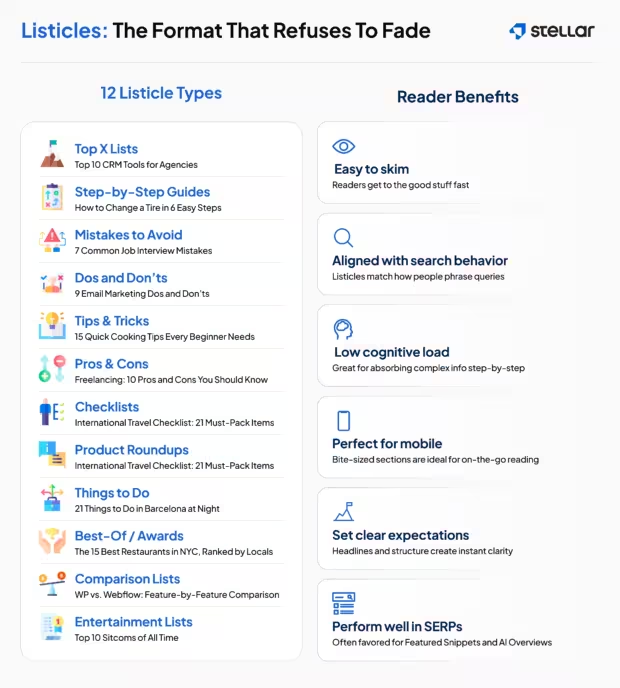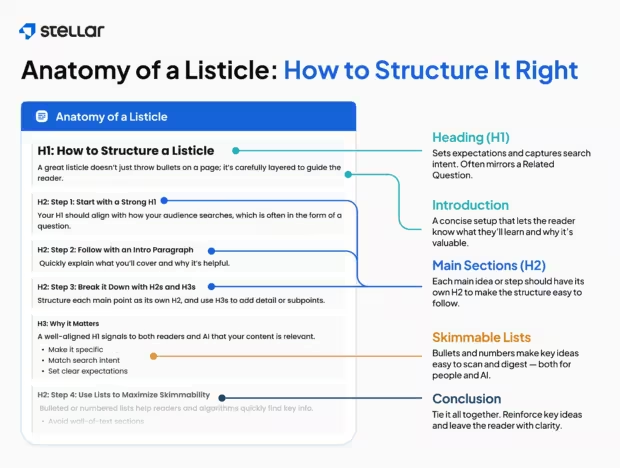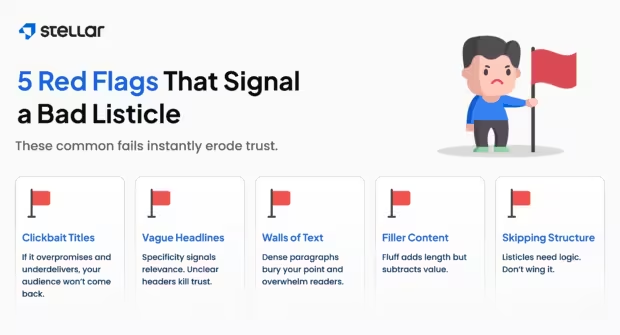
Why does the internet love listicles?
Readers want info that’s easy to digest. Listicles break down complex information into an easily skimmable and quickly accessible format.
We skim headings to get a gist of the article and to gauge whether we’ve landed in the best place to find what we want to know.
Because human readers often engage with content this way, search engines tend to analyze content in a similar fashion.
But you can’t give readers and search engines what they want without learning the basics. That’s why we’ve created this guide on how to write a listicle using today’s best practices.
Here’s a quick rundown of how to write an effective listicle that’s just as popular with humans as search engines:
- Choose a compelling topic.
- Research readers’ questions (like “People Also Ask” on Google).
- Create a clear, logical outline.
- Prioritize actionable, useful guidance.
- Utilize logical, hierarchical headings.
- Break up text with bullets and numbered lists.
- Test the process.
You’ll notice that this article is actually a listicle and is formatted as an example of how to use these tips and best practices.
Are listicles still popular?
Listicles remain one of the most effective content formats for readers, especially online. This trend will likely continue because these articles give the brain what it wants:
- Information that is organized in a digestible, reader-friendly format
- Content that is easy to skim and scan
- Clear, concise takeaways
- Quick answers to questions
This format is versatile, scalable, and works for nearly any industry or topic.
In fact, the rise of Google’s AI Overviews reiterates how effective and popular listicles are. Have you noticed that they are almost always formatted in a listicle format, no matter how the content they draw from is presented?
The format seems to be here to stay. Beyond online listicles decades long popularity, historical examples only further prove their enduring popularity:
- Mesopotamians used bullae back in 3500 BC to track resources. These clay containers and tokens featured lists of resources.
- In Ancient Egypt, The Maxims of Ptahhotep showcased advice in list format.
- A Japanese woman named Sei Shonagon wrote The Pillow Book during the 11th century. This book contains a collection of lists about court life.
- Early religious texts, like the Ten Commandments, rely on list-based structures, and lists help our brains organize, evaluate and comprehend information.
Keep your readers engaged by mastering the art of listicle creation.

How to write a listicle: step by step
Every listicle is different, but each follows a predictable structure. Here’s a step-by-step breakdown of how to create an engaging list-style article.
1. Choose a compelling topic
Select a topic your audience cares about, whether that’s trends in nursing or the best spices for pasta. You want to provide information that is engaging but useful. Your article should answer a question or solve a problem.
- A listicle’s topic shouldn’t require in-depth analysis.
- Heavily researched subjects are better suited for blog posts or news articles.
- Consider topics that work well as standalone themes, such as “10 Beach-Day Essentials” or “7 Classroom Supplies Every Kindergarten Teacher Needs.”
Broader topics, such as a detailed guide to every species found in the ocean, are not ideal for this format.
2. Research readers’ questions
Don’t try to guess what information will benefit your audience.
- Google your listicle topic and check the People Also Ask and Related Searches sections. These sections provide insight into what your readers want to know.
- Consider researching user generated content such as Reddit communities
- Use a keyword or SEO tool for content ideas.
Understanding your audience can help you tailor your listicle toward their needs. Strive to entertain yet inform readers as you address questions and concerns about a topic.
3. Create a clear, logical outline
Structure and organization are important for all types of content, but are essential for creating a listicle.
- Carefully plan each section of your article before you begin writing.
- Create a clear outline that includes chronological steps or grouped themes to prevent repetition and ensure you address your audience’s questions.
4. Prioritize actionable, useful guidance
Listicles aren’t for regurgitating the same information readers can find with a quick Google search. Show you respect your audience’s time by prioritizing actionable steps and helpful suggestions.
Think of unique ideas that benefit your readers without being over-the-top or impractical. You want to help your readers, not just hit your recommended word count. Figure out how you can make life better for your audience and offer value-minded tips or beneficial tools.
5. Utilize logical, hierarchical headings
Make content skimmable with logical, hierarchical headings that help readers quickly determine what your piece covers.
Here’s how to format headings for your listicle:
- Include an H1 for your title
- Use H2s for main sections
- Consider H3s and H4s that break down main sections into subsections
These HTML headings benefit readers, but they also help search engines understand the progression and flow of your content.
Translation: You’re more likely to show up in search results when the search engine knows what your content is about.
Keep headings brief. If you’re writing an article about cute animals, a relevant H2 might be “Calico Cats.” An H2 like “Soft White Cats With Brown or Tan Spots” is too wordy and makes it harder for readers to scan listicle sections.
6. Break up text with bullets and numbered lists
Make it easy for your audience to skim content by avoiding large blocks of text and including bulleted or numbered lists.
Instead of writing a lengthy paragraph about popular SEO hacks, create a bulleted list that briefly describes them.
Bold, highlighted or italic text can also make your content easier to skim.
7. Test the process
Advice isn’t helpful if it doesn’t work. Test the suggestions you offer readers, and keep an eye on your article’s traffic. A high bounce rate means your listicle doesn’t offer value to its audience.
Sometimes, a slow-loading page, poorly placed images or formatting problems can lead to a high bounce rate. If your content seems to represent what readers want, consider that your website or the article’s layout may be the problem.
Listicle best practices
Feel like you’ve mastered the basics? We’ve got additional tips and guidance for creating a high-quality listicle if you’re ready to dive deeper.
What are the features of a listicle?
Listicles are known for being skimmable articles with clear headings. Many listicles are broken into numbered headers or H2s and H3s.
Content should be scannable and use proper formatting. Write for your audience, not yourself, and make sure suggestions benefit them.
Let’s run through the features of a listicle in more detail below.
Hierarchical headings
Introduce your topic with an H1, which is your title tag.
Break the topic down using H2s.
Some listicles may also need H3s and H4s. These subsections provide additional information about the main headers.
In the listicle you’re reading now, the header above, “Hierarchical headings,” is an H4.
- This H4 supports the H3 header titled “What are the features of a listicle?”
- “Listicle best practices” is the H2 header, which is the main header for the H3 and H4 headers described above.
Organize headers in a way that maximizes understanding and impact. You are a subject matter expert, so present your information in a logical, easy-to-digest way.
Actionable steps or helpful tips
Your article should deliver a clear takeaway for readers, whether you’re offering marketing tips or gift suggestions. Your readers should feel like all their questions were answered.
Every header should offer value and be specific. A well-crafted listicle entertains or informs readers (preferably both).
Bulleted or numbered lists
You have less than 10 seconds to capture your audience’s attention. Keep them on your page with bulleted or numbered lists that provide quick, scannable facts.
Keep your lists short. Your audience doesn’t want you to dump 20 items on a numbered list. Save that info for your H2s!
Short paragraphs
This isn’t a college essay. Keep paragraphs short — less is more, as the saying goes. Avoid walls of text.
Listicle paragraphs typically contain 2 to 4 sentences. You can also publish a single sentence as a paragraph if you want the information to stand out. This works well for questions or key facts.
See what we did here?
How to structure a listicle
Listicles are formulaic articles that rely on a specific structure. Organize your article correctly to keep readers engaged and educated.
Your listicle should begin with an H1 heading above the introduction, followed by H2 and H3 headers. Bullets and numbered lists help further organize information and improve skimmability.
Below, we break down the importance of each section and feature.
H1 heading
Your introduction should sit below your H1 header, which is your article’s title. Ensure your H1 matches a related question or search query that interests your audience. Use their language, not industry jargon or highly formal terms.
Some listicles dive straight into numbered headers, but this can confuse readers. Use your introduction to briefly explain your article’s topic and why the information will benefit your audience.
H2 headers
Use H2s to represent major sections in your listicle. These might be steps in a step-by-step article or actionable tips. Use a separate heading for each step, tip or item on your list.
H3 headers
H3s add structure and clarity to your H2s. Continue to logically organize and break down concepts in a neat, easy-to-follow way by using subheadings for related subtopics.
If concepts can be broken down further, use H4 headers, bulleted or numbered lists, or bold text.
Bullets or numbered lists
Organize information under headers with bullets or numbered lists that enhance scannability. Human readers want to find important information quickly. Search engines have a similar goal when analyzing your website. A quick page scan should make it simple for search engines to understand your target audience and share your work with the right readers.
Your conclusion is also a great place to include bullets or numbered lists of key takeaways.

How long should a listicle be?
As long as your audience wants it to be! As long as it needs to be to cover the topic and keep your audience from having to return to search results to learn everything they need to know.
There isn’t an industry standard for article length, so focus on being helpful and comprehensive.
Make the piece as long as necessary to satisfy your audience. It should contain a comprehensive topic overview while balancing conciseness.
Remember, comprehensive doesn’t have to mean lengthy!
- Strive to research, include and address your audience’s questions.
- Educate yourself on what your audience cares about so you can anticipate questions readers may have.
- Create content with the correct information and then develop it using the right format.
- Don’t waste space with filler words or fluff to hit an arbitrary word count. Useful content that makes readers happy has a better chance of reaching your target audience.
Consider competitors
Research competition for a ballpark estimate of where your content should be. Keep in mind that rankings can change at any time. Today’s popular content may tank tomorrow, so be prepared to evolve if you aren’t creating evergreen listicles.
Aim to do better than what’s currently available. Be more helpful, comprehensive, clear and concise than competitors.
What not to do when writing a listicle
Avoid doing anything that misleads or confuses your audience when you write a listicle. Don’t format your article in a way that makes it hard to skim the content. Avoid large blocks of text, as this makes it harder for readers to digest and access your content. Below are some common mistakes to watch for.
Clickbait
Your content must meet any expectations you set. If you mislead or disappoint readers, you may as well send them straight to your competition.
Confusing headlines
Headlines should be clear, direct and specific. Set the ideal expectation for what your content provides and then deliver on it.
Walls of text
Always aim for an orderly, concise and easily digestible format. Large chunks of text distract readers and discourage them from finishing your article.
Utilize bulleted lists or numbered lists, and include images throughout your listicle. Bold sentences or put words in italics. These actions can help eliminate dense content.
Fluff and filler
Never add words just for the sake of increasing length. Every word in your listicle should be helpful and actionable.
Sentences should help contribute to the reader’s understanding and goals, not confuse or annoy your audience. Use simple terms.
Pretend you’re writing for older elementary school students or middle schoolers, even if your article is geared toward executives. Avoid run-on sentences and content cluttered with unnecessary adjectives and adverbs.
Shortcuts
Don’t take shortcuts! Aim to cover a topic in a comprehensive, helpful way rather than sharing vague or incomplete content.
Anticipate your audience’s questions and structure the article to address them. Otherwise, they may leave your page to find answers.

Does a listicle need a conclusion?
Every listicle doesn’t need a conclusion, but many can benefit from one.
These pieces often provide step-by-step guidance, pros, cons, benefits and actionable tips. A conclusion lets you concisely summarize the main points and takeaways that would be most helpful to the reader.
Before writing your conclusion, ensure your article is truly complete. Content should be formatted properly and include information that benefits and interests your audience. Make sure you have an intro, H2 headers, H3 headers, bulleted lists and images.
Correct any grammar issues, and make sure your readers’ questions are thoroughly addressed. Once you’re certain your content is clear, scannable and accurate, hit the publish button.
